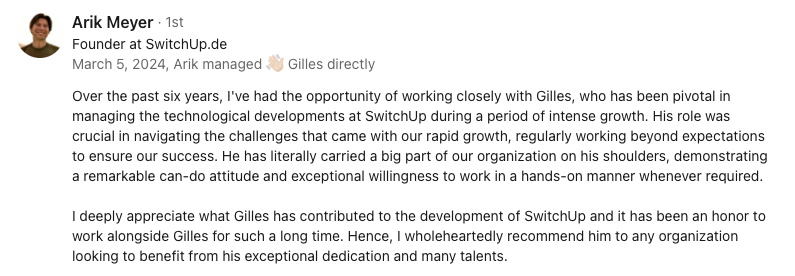Optimizing Tech Innovations: The Role of RL in Autonomous Systems
Abstract:
Reinforcement learning (RL) is a form of machine learning that enables autonomous systems to make intelligent decisions in complex environments. It is crucial for autonomous vehicles and robotics, as it allows them to adapt to dynamic conditions and interact collaboratively with humans. Technology and engineering leaders must understand RL, AI, and autonomous systems to effectively manage teams and drive innovation. Leaders also face resource allocation challenges, needing to balance investments in foundational research and product development. Those overseeing RL initiatives must understand the technology to allocate resources effectively and attract talent. Collaboration between technology and engineering leaders is essential for successful resource allocation, driving balanced and strategic innovation and growth.
introduction to reinforcement learning in autonomous systems
Reinforcement learning (RL) is like giving a machine a brain and some candy. It’s a subset of machine learning where an agent learns to make decisions by interacting with its environment and receiving feedback in the form of rewards or penalties. Think of RL as training a dog to fetch—only the dog is a smart piece of technology, and instead of treats, it gets virtual rewards.
Now, imagine applying this powerful technique to autonomous systems such as self-driving cars, drones, and robots. These systems navigate complex and unpredictable environments, and RL empowers them to make intelligent decisions on their own. It’s like having a really smart co-pilot who learns from every turn and twist. But instead of backseat driving, it’s guiding the vehicle to perform optimally.
This article delves into the pivotal role of RL in the context of autonomous systems. From the remarkable advancements in autonomous vehicles and robotics to grasping the essence of RL, AI, and resource allocation, our journey will explore various aspects of optimizing tech innovations. As a CTO, I’ve seen firsthand the transformative impact RL can have, setting the stage for an exciting payoff in technological advancements.
the importance of RL in autonomous vehicles and robotics
Reinforcement learning (RL) is the secret sauce behind the mind-boggling capabilities of autonomous vehicles and robotics. Simply put, RL enables these machines to learn from their experiences and adapt to ever-changing conditions. It’s not just about sticking to a fixed set of instructions; it's about developing the ability to make smart decisions on the fly.
In the bustling world of autonomous vehicles, RL is what helps a self-driving car navigate through traffic, recognize obstacles, and adapt to unpredictable road situations. Picture a car that’s learning to handle rush hour traffic like a pro, all thanks to RL. It’s not just avoiding accidents but also figuring out the most efficient routes, ensuring a smooth ride from point A to B.
In the sphere of robotics, RL enables robots to perform complex tasks with precision and finesse. Whether it’s a robotic arm in a manufacturing plant learning to assemble components seamlessly, or a service robot navigating a hospital to deliver medicines, RL ensures these machines work autonomously and intelligently. Think of it as having a highly skilled apprentice who learns and improves without any hand-holding.
Real-world applications abound. Amazon’s warehouse robots, for example, use RL to optimize their movements, significantly boosting efficiency and reducing errors. On the road, companies like Tesla and Waymo leverage RL to enhance their self-driving technologies, pushing the boundaries of what autonomous vehicles can achieve.
Ultimately, RL transforms autonomous systems into adaptable, intelligent entities capable of seamless human-machine interaction. It’s about machines that learn, grow, and excel—much like a diligent student—but with a lot more computing power and fewer teenage rebellions.
understanding RL, AI, and autonomous systems for technology leaders
For technology and engineering leaders, having a solid grasp of reinforcement learning (RL), artificial intelligence (AI), and autonomous systems is critical. These technologies represent the backbone of future innovations, directly influencing a company's competitive edge and operational efficiency. It's not just about being tech-savvy; it's about being able to guide your team through the nuances of these complex fields.
First off, let's break down the basics. RL is a subset of AI focused on training agents through reward-based feedback. It’s like teaching a pigeons to peck a button for food—only in this case, the "pigeons" are sophisticated algorithms making decisions in real-time. Understanding this feedback loop is essential for identifying the potential applications and limitations of RL in your projects.
Moreover, effective use of AI and autonomous systems requires a keen understanding of data. Data isn't just the new oil; it's the omega-3 for your algorithms. Leaders must appreciate the significance of data quality, acquisition, and preprocessing to enable successful RL implementations. Bad data is like feeding your smart dog junk food—it won't end well.
Leadership in these domains isn't just about technical knowledge; it's about fostering an environment where innovation thrives. You need to create a team culture that encourages experimentation and rapid prototyping. Understanding these technologies allows you to communicate better with your team, making you a more effective leader.
Additionally, it's crucial to stay updated with the latest breakthroughs and trends. This knowledge helps in identifying promising areas for investment and development. Consider RL’s evolving role in personalized medicine, autonomous vehicles, and even financial modeling. A well-informed leader can turn these trends into strategic opportunities.
In essence, a robust understanding of RL, AI, and autonomous systems equips technology leaders with the tools to drive innovation, streamline operations, and ultimately boost their organization's technological prowess. It's like being the captain of a ship, navigating through the uncharted waters of technology with confidence and foresight.
the role of resource allocation in RL initiatives
One of the trickiest challenges for anyone overseeing reinforcement learning (RL) initiatives is getting resource allocation right. The balance between investing in foundational research and product development can mean the difference between a breakthrough innovation and a forgotten project. It’s not just about throwing money into the pot; it’s about knowing exactly where and when to invest it.
Let me put it this way: imagine you’re at a fancy buffet, but you have a limited stomach capacity. You want to sample the exquisite dishes (foundational research) while also saving room for the dessert (product development). Misjudge the portions, and you either miss out on some culinary delight or overeat and regret it later. Similarly, in RL initiatives, strategic resource allocation is all about making those crucial calls—balancing immediate needs with long-term goals.
Foundational research is where the innovation ground is tilled. You need the best minds and adequate funding to explore new algorithms, experiment with data sets, and build initial models. However, this cannot be at the expense of product development, where these models are put to the test in real-world applications. After all, what good is a brilliant algorithm if it sits unused in a research paper?
Industry experts often highlight the need for flexibility in resource allocation. Mihir Kamdar, a leading AI researcher, suggests, “A balanced approach is crucial. You need to fund exploratory projects but also have a pivot strategy to quickly reallocate resources to promising developments.” Being dynamic and adaptable in resource management ensures you’re not left behind in the fast-paced tech environment.
Resource allocation isn't solely about financial capital either; it encompasses time, talent, and technological infrastructure. Effective allocation needs capable hands on deck. That’s why attracting and maintaining skilled professionals becomes vital—ensuring they have the necessary tools and time to tackle challenges can significantly influence the outcome of your RL initiatives.
Ultimately, resource allocation is like playing a high-stakes chess game where each move can make or break your strategy. You need to think several steps ahead, be prepared to adjust as conditions change, and always keep an eye on both your current position and the endgame. Get it right, and you’ll set the stage for remarkable advancements in RL. Get it wrong, and you might find yourself resetting the board.
attracting and retaining talent for RL projects
Hiring and retaining top talent is crucial for the success of RL projects. Think of it as assembling a dream team for your local sports league—your all-stars make the difference between a win and a stumble. For RL initiatives, it’s not just about finding talented individuals; it’s about keeping them engaged and motivated to push the boundaries of what’s possible.
First off, understanding RL technology at a granular level is key for leaders. It lets you speak the same language as potential hires, making your organization more attractive to top-tier talent. When candidates know their future boss 'gets it,' they’re more likely to want to join and stay on board. They’ll appreciate that you understand the complexities and nuances they deal with daily.
Building an appealing work environment is another cornerstone. Skip the ping-pong tables and go for what truly matters: intellectual challenges, access to cutting-edge tools, and a collaborative culture. Create an environment where innovation and creativity flourish, and trust me, word will spread within the tight-knit community of RL experts.
Support continual learning and development. RL is a fast-moving field where yesterday’s breakthrough can become today’s standard. Providing opportunities for your team to attend conferences, pursue advanced studies, or even just tinker with side projects can make a huge difference. After all, no one wants to feel like they’re on a hamster wheel instead of a rocket ship.
Let’s not forget the importance of recognizing and rewarding contributions. Acknowledging achievements, whether through bonuses, promotions, or simple public recognition, goes a long way. It’s like giving your star players a standing ovation—they’ll play even harder because they know their efforts are valued.
In summation, attracting and retaining talent for RL projects isn’t rocket science; it’s about creating a workplace where top minds feel supported, challenged, and valued. It’s the difference between being a place where people work and a place where they thrive.
collaboration between technology and engineering leaders for successful resource allocation
Ensuring successful resource allocation requires technology and engineering leaders to engage in effective collaboration. Think of it as a harmony orchestra where every instrument must play in sync for an outstanding performance. This teamwork drives balanced and strategic innovation, enabling organizations to fuel long-term growth and operational efficiency.
For instance, technology leaders often focus on the big picture, identifying key trends, and setting strategic directions. Meanwhile, engineering leaders dive into the technical weeds, ensuring the feasibility and execution of these strategies. By joining forces, these two groups can blend visionary thinking with practical execution, creating a robust pipeline for innovation.
One classic example is the collaboration between the tech giant Google and its Waymo division. Google's strategic vision, married with Waymo’s engineering prowess, resulted in groundbreaking advancements in autonomous driving. This partnership allowed resources to flow seamlessly from high-level innovation to ground-breaking technical development, producing tangible results in the autonomous vehicle space.
Another successful case is Amazon’s partnership between its software and hardware teams. By aligning their goals and sharing insights, they managed to optimize the algorithms and mechanical functions of their warehouse robots. This cooperation significantly trimmed inefficiencies and accelerated productivity, setting a new benchmark in logistics automation.
Effective collaboration also involves regular, transparent communication. Weekly sync-ups, project updates, and feedback loops ensure that both teams stay aligned. It's like a well-coordinated double play in baseball—each player knows exactly when and where to throw, capturing the opponent out with ease.
Lastly, fostering a culture that values cross-functional interaction and joint problem-solving is paramount. Encouraging engineers to present at tech leader meetings and inviting technology leads to engineering scrums can build mutual respect and understanding. This cross-pollination of ideas leads to more informed decisions and creative solutions.
In sum, the symbiotic relationship between technology and engineering leaders can transform resource allocation from a daunting task into a strategic advantage. It's all about blending visionary thinking with technical expertise to drive innovation and achieve successful outcomes.
future of RL in autonomous systems and leadership in technology
The journey we've explored paints a vivid picture of the immense potential and complexity inherent in RL technology. Reinforcement learning is not just a buzzword—it's the fuel that powers the next generation of autonomous systems. The pivotal role of effective leadership in steering these innovations cannot be overstated.
As we look forward, it’s clear that RL's evolution hinges on collaborative resource allocation, robust talent management, and seamless tech-engineering leadership. We stand on the brink of incredible breakthroughs, and it's up to us to navigate this future with strategic vision and adaptive management. Here’s to smarter machines and even smarter leaders!
You might be interested by these articles:
- Real-World Applications of Reinforcement Learning
- Mastering EU Regulations for Reinforcement Learning Success





